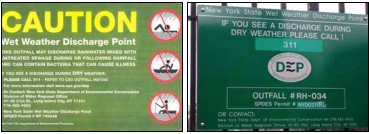FOR IMMEDIATE RELEASE11-15 February 25, 2011 CONTACT: Farrell Sklerov / Mercedes Padilla (718) 595-6600 DEP Replaces Sewer Outfall Signs in New York CityUpdated Design Offers Additional Information of Non-Recommended Activities at Outfall Locations; Encourages the Public to Report Dry Weather DischargesEnvironmental Protection Commissioner Cas Holloway today announced that DEP has completed the replacement of all 410 signs marking the combined sewer overflow outfalls in New York City. The updated design now includes warnings about fishing, swimming, and boating near specific sewer outfalls, which will assist the public in making informed decisions about recreational opportunities when it rains. An outfall is an outlet along the waterfront that connects sewers to open waters. During heavy storms, the sewer system can reach capacity in certain parts of the City, and must discharge a mix of excess stormwater and wastewater — called a combined sewer overflow, or CSO — into the surrounding waterways. The new signs continue to advise the public to inform the city of any dry weather overflows by calling 311. The City’s sewer system has the capacity to handle the 1.3 billion gallons of wastewater that New Yorkers generate on average dry day; overflows during dry weather are usually caused by illegal dumping of prohibited materials into the sewer. Each of the new 410 signs has a unique identification number, making it easier for authorities to investigate quickly if a dry weather discharge is reported. “Like many cities in the Northeast and Midwest, New York City is served by a combined sewer system,” said Commissioner Holloway. “Though our system can easily handle normal flow on a dry day, sometimes heavy rains trigger combined sewer overflows which can impair our surrounding waterways. Reducing the frequency and intensity of overflows has been a major priority for the Bloomberg Administration. With $7 billion invested since 2002, and major new efforts like the NYC Green Infrastructure Plan which will cut CSOs by 40% over the next 20 years, New York Harbor is cleaner than it’s been at any time in the last 100 years. But CSOs still occur, and residents and visitors who want to take advantage of the City’s waterways should take common-sense precautions near an outfall when it rains. These new signs are designed to help that effort.” DEP changed the design of the outfall signs at the suggestion Floatable Citizens’ Advisory Committee which, as part of DEP’s Open Water CSO Long Term Control Plan, recommended including more friendly information about the water quality at these locations. The new design includes the approval of Department of Environmental Conservation, the NYC Arts Commission, and the NYC Parks Department, as well as community boards in the five boroughs. Producing and replacing the signs cost approximately $1 million. Images of the old (left) and new design for the outfall signs:
The structures that connect to public and private sewers that discharge into the surrounding waters are known as combined sewer outfalls. Each outfall has a sign of 24-by-36 inches and each sign faces the water and the land to give the public the opportunity to read the information and report illegal discharges right away. The signs also provide contact numbers so people can call to report sewage releases during dry weather. The identification number can help a 311 operator or a DEP employee recognize the location from where someone is reporting discharges and take immediate action. The outfall signs are part of the New York State Discharge Notification Act that requires all permitted CSO discharges to have signs identifying CSO outfalls. In September, Mayor Bloomberg unveiled the NYC Green Infrastructure Plan, which will improve harbor water quality by capturing and retaining stormwater runoff before it enters the sewer system. The plan, which includes $2.4 billion in green infrastructure, will reduce sewer overflows by 40% by 2030. This approach will also save $2.4 billion over the next 20 years because it will reduce more costly investments in traditional sewage retention projects, like tanks and tunnels. Green infrastructure uses vegetation, soils, and other structural elements to absorb and evaporate water and to mimic natural areas and hydrologic cycles. These types of projects are a key component of PlaNYC’s sustainability effort because they also shade and cool the city, improve air quality, and increase property values. These characteristics, the minimal energy and manpower required for operation, and the relatively quick installation mean that green infrastructure can be cost-effective and provide immediate benefits. The Green Infrastructure Plan has been submitted for approval to the State Department of Environmental Conservation in order for the plan to move forward. DEP manages the city’s water supply, providing more than 1 billion gallons of water each day to more than 9 million residents, including 8 million in New York City. New York City’s water is delivered from a watershed that extends more than 125 miles from the city, and comprises 19 reservoirs, and three controlled lakes. Approximately 7,000 miles of water mains, tunnels and aqueducts bring water to homes and businesses throughout the five boroughs, and 7,400 miles of sewer lines take wastewater to 14 in-city treatment plants. For more information, visit www.nyc.gov/dep or follow us on Facebook at www.facebook.com/nycwater. | ||
